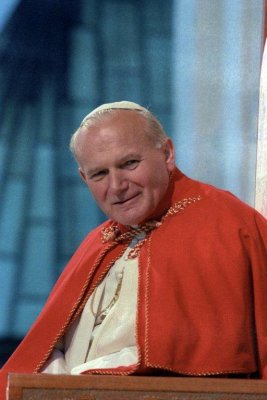2. "You are the salt of the earth... You are the light of the world" (Mt 5:13-14): this is the theme I have chosen for the next World Youth Day. The images of salt and light used by Jesus are rich in meaning and complement each other. In ancient times, salt and light were seen as essential elements of life.
"You are the salt of the earth...". One of the main functions of salt is to season food, to give it taste and flavour. This image reminds us that, through Baptism, our whole being has been profoundly changed, because it has been "seasoned" with the new life which comes from Christ (cf. Rom 6:4). The salt which keeps our Christian identity intact even in a very secularized world is the grace of Baptism. Through Baptism we are re-born. We begin to live in Christ and become capable of responding to his call to "offer [our] bodies as a living sacrifice, holy and acceptable to God" (Rom 12:1). Writing to the Christians of Rome, Saint Paul urges them to show clearly that their way of living and thinking was different from that of their contemporaries: "Do not be conformed to this world, but be transformed by the renewal of your mind, that you may discern what is the will of God, what is good and pleasing and perfect" (Rom 12:2).
For a long time, salt was also used to preserve food. As the salt of the earth, you are called to preserve the faith which you have received and to pass it on intact to others. Your generation is being challenged in a special way to keep safe the deposit of faith (cf. 2 Th 2:15; 1 Tim 6:20; 2 Tim 1:14).
Discover your Christian roots, learn about the Church’s history, deepen your knowledge of the spiritual heritage which has been passed on to you, follow in the footsteps of the witnesses and teachers who have gone before you! Only by staying faithful to God’s commandments, to the Covenant which Christ sealed with his blood poured out on the Cross, will you be the apostles and witnesses of the new millennium.
3. "You are the light of the world...". For those who first heard Jesus, as for us, the symbol of light evokes the desire for truth and the thirst for the fullness of knowledge which are imprinted deep within every human being.
When the light fades or vanishes altogether, we no longer see things as they really are. In the heart of the night we can feel frightened and insecure, and we impatiently await the coming of the light of dawn. Dear young people, it is up to you to be the watchmen of the morning (cf. Is 21:11-12) who announce the coming of the sun who is the Risen Christ!
The light which Jesus speaks of in the Gospel is the light of faith, God’s free gift, which enlightens the heart and clarifies the mind. "It is the God who said, ‘Let light shine out of darkness’, who has shone in our hearts to give the light of the knowledge of the glory of God on the face of Christ" (2 Cor 4:6). That is why the words of Jesus explaining his identity and his mission are so important: "I am the light of the world; whoever follows me will not walk in darkness, but will have the light of life" (Jn 8:12).
Our personal encounter with Christ bathes life in new light, sets us on the right path, and sends us out to be his witnesses. This new way of looking at the world and at people, which comes to us from him, leads us more deeply into the mystery of faith, which is not just a collection of theoretical assertions to be accepted and approved by the mind, but an experience to be had, a truth to be lived, the salt and light of all reality (cf. Veritatis Splendor, 88).
In this secularized age, when many of our contemporaries think and act as if God did not exist or are attracted to irrational forms of religion, it is you, dear young people, who must show that faith is a personal decision which involves your whole life. Let the Gospel be the measure and guide of life’s decisions and plans! Then you will be missionaries in all that you do and say, and wherever you work and live you will be signs of God’s love, credible witnesses to the loving presence of Jesus Christ. Never forget: "No one lights a lamp and then puts it under a bushel" (Mt 5:15)!
Just as salt gives flavour to food and light illumines the darkness, so too holiness gives full meaning to life and makes it reflect God’s glory. How many saints, especially young saints, can we count in the Church’s history! In their love for God their heroic virtues shone before the world, and so they became models of life which the Church has held up for imitation by all. Let us remember only a few of them: Agnes of Rome, Andrew of Phú Yên, Pedro Calungsod, Josephine Bakhita, Thérèse of Lisieux, Pier Giorgio Frassati, Marcel Callo, Francisco Castelló Aleu or again Kateri Tekakwitha, the young Iroquois called "the Lily of the Mohawks". Through the intercession of this great host of witnesses, may God make you too, dear young people, the saints of the third millennium!










